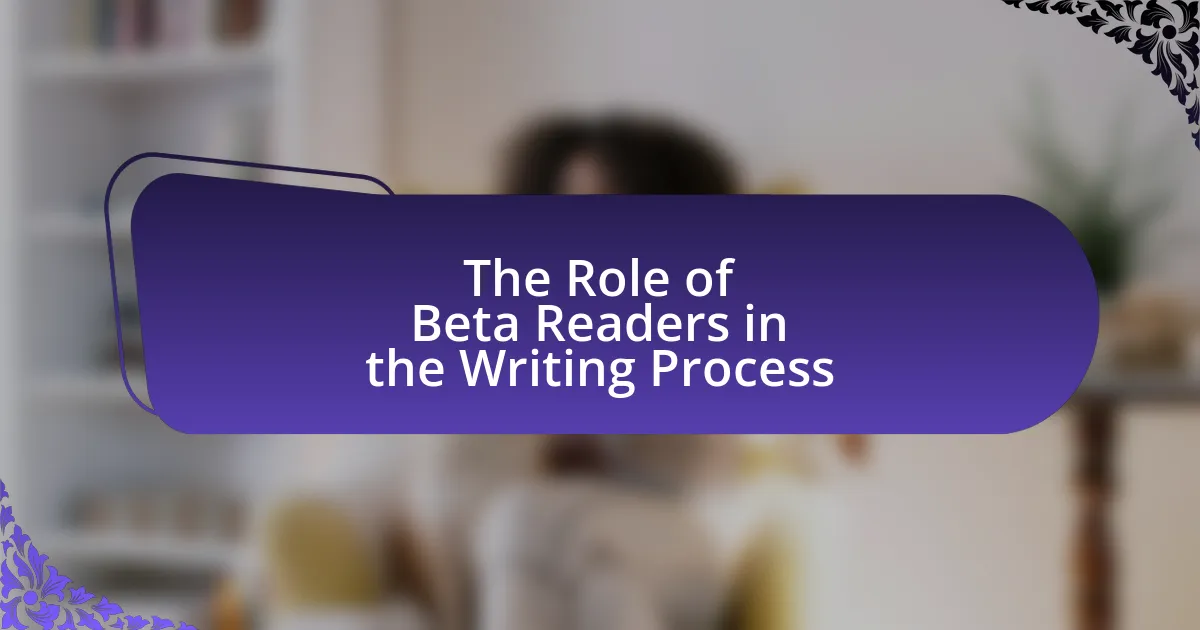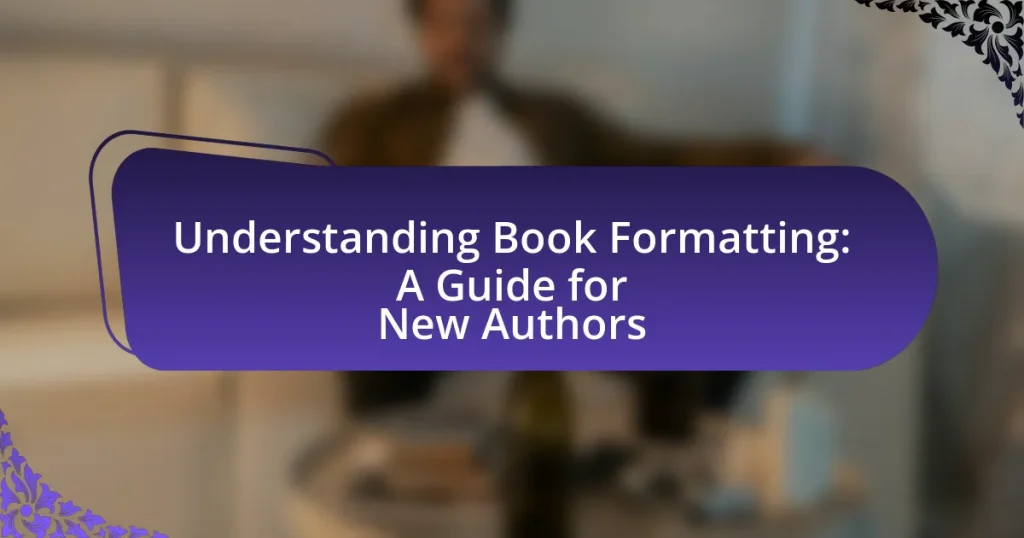Beta readers are individuals who provide critical feedback on a manuscript before its publication, playing a vital role in the writing process. They help authors identify strengths and weaknesses in plot, character development, pacing, and overall readability, leading to significant improvements in the manuscript’s quality. The article explores the specific contributions of beta readers, the types of feedback they provide, and the best practices for writers to effectively utilize this feedback. It also discusses the importance of selecting suitable beta readers, managing conflicting feedback, and maintaining positive relationships throughout the beta reading process.
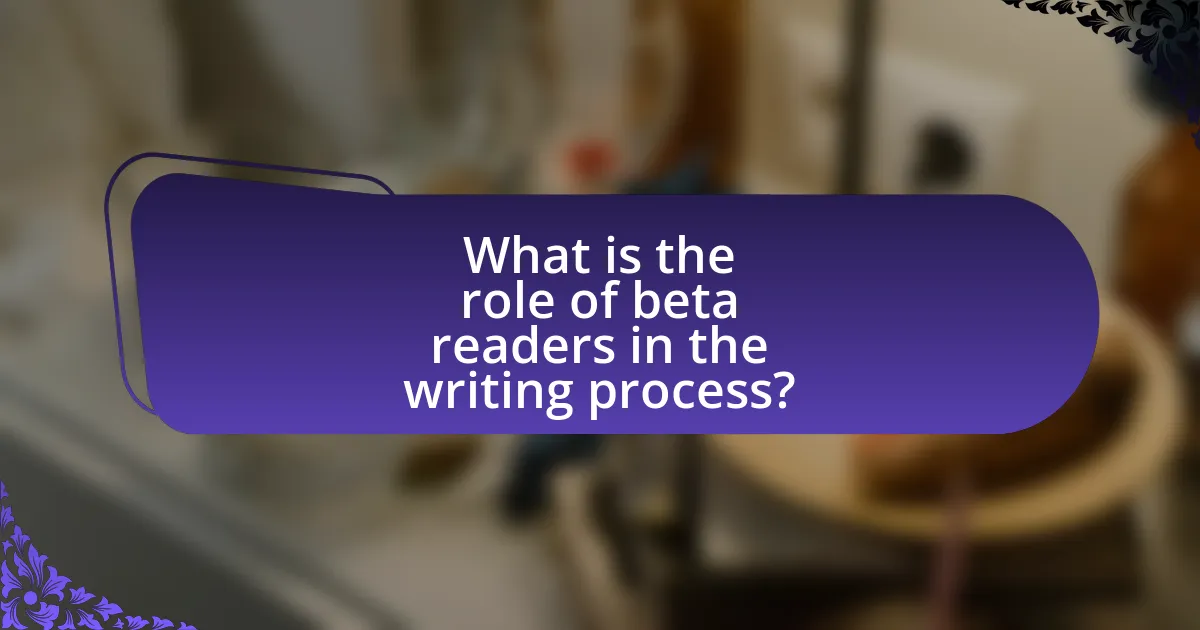
What is the role of beta readers in the writing process?
Beta readers play a crucial role in the writing process by providing feedback on a manuscript before it is published. Their insights help authors identify strengths and weaknesses in plot, character development, pacing, and overall readability. By offering an external perspective, beta readers can highlight areas that may confuse or disengage potential readers, allowing authors to make necessary revisions. This feedback is essential, as studies show that manuscripts revised based on reader input often result in higher reader satisfaction and better sales performance.
How do beta readers contribute to the development of a manuscript?
Beta readers contribute to the development of a manuscript by providing critical feedback on elements such as plot, character development, pacing, and overall readability. Their insights help authors identify strengths and weaknesses in the narrative, allowing for revisions that enhance the manuscript’s quality. Research indicates that feedback from beta readers can lead to significant improvements in a manuscript’s coherence and engagement, as they represent the target audience and offer perspectives that the author may overlook. This collaborative process ultimately results in a more polished and compelling final product.
What specific feedback do beta readers provide to authors?
Beta readers provide authors with specific feedback on plot coherence, character development, pacing, and overall engagement of the narrative. This feedback helps authors identify strengths and weaknesses in their manuscript, allowing for targeted revisions. For instance, beta readers may point out inconsistencies in the plot that could confuse readers or suggest that certain characters lack depth, which can hinder emotional connection. Additionally, they often comment on the pacing, indicating sections that may drag or feel rushed, thus guiding authors to enhance the flow of the story. This type of feedback is crucial as it reflects the perspective of potential readers, making it a valuable resource for authors aiming to improve their work before publication.
How does the feedback from beta readers influence revisions?
Feedback from beta readers significantly influences revisions by providing insights into the clarity, pacing, and emotional impact of a manuscript. This feedback helps authors identify areas that may confuse readers or fail to engage them effectively. For instance, if multiple beta readers express confusion about a character’s motivation, the author can revise that aspect to enhance understanding and connection. Additionally, beta readers often highlight strengths and weaknesses in plot development, allowing authors to refine their narratives based on real reader experiences. This iterative process of receiving and implementing feedback ultimately leads to a more polished and reader-friendly final product.
Why are beta readers important for writers?
Beta readers are important for writers because they provide critical feedback on a manuscript before publication. This feedback helps writers identify strengths and weaknesses in their work, ensuring that the narrative is engaging and coherent. Studies show that manuscripts reviewed by beta readers often undergo significant improvements, as these readers can highlight areas of confusion, pacing issues, and character development flaws that the author may overlook. By incorporating this external perspective, writers can enhance the overall quality of their writing, leading to a more polished final product.
What advantages do beta readers offer in terms of perspective?
Beta readers provide valuable advantages in terms of perspective by offering diverse viewpoints that reflect the target audience’s reactions. Their feedback helps authors identify strengths and weaknesses in plot, character development, and pacing, ensuring the narrative resonates with readers. For instance, a study by the University of Southern California found that reader feedback significantly enhances narrative engagement, highlighting the importance of understanding audience perception. This external perspective allows writers to refine their work, making it more relatable and impactful.
How can beta readers help identify plot holes and inconsistencies?
Beta readers can help identify plot holes and inconsistencies by providing fresh perspectives on the narrative. Their feedback often highlights areas where the story lacks clarity or logical progression, which the original author may overlook due to familiarity with the material. For instance, beta readers can point out contradictions in character behavior or events that do not align with established plot points, thereby ensuring the story maintains internal consistency. This process is supported by the fact that studies in narrative theory emphasize the importance of external feedback in refining story structure and coherence, demonstrating that diverse viewpoints can significantly enhance the quality of a manuscript.
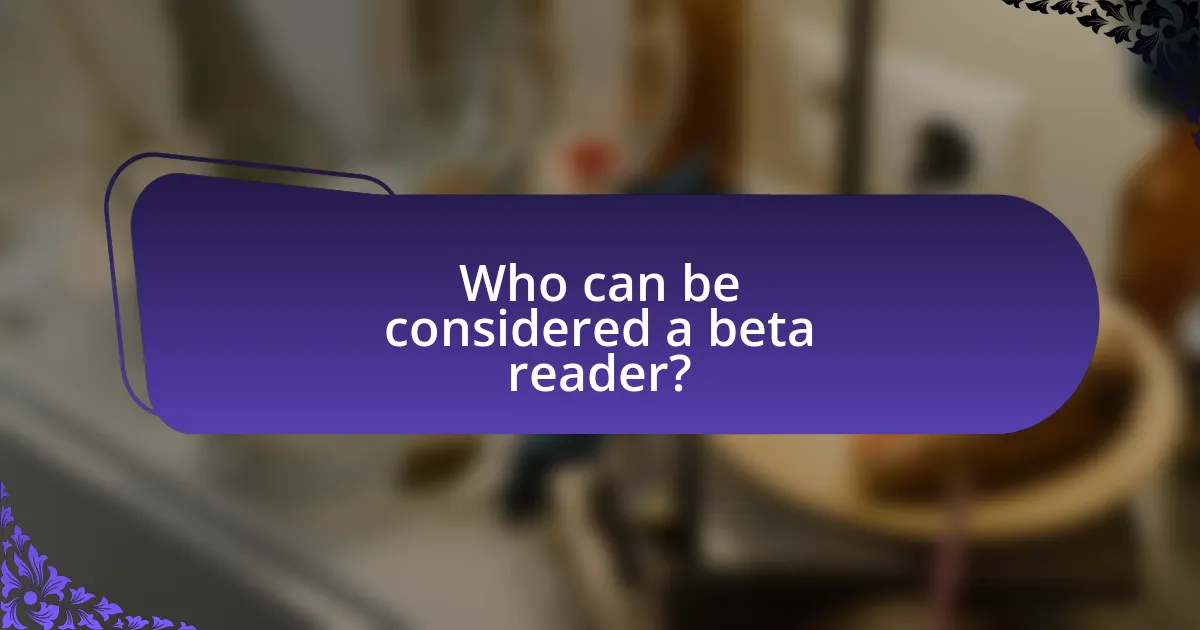
Who can be considered a beta reader?
A beta reader is typically an individual who reads a manuscript before it is published to provide feedback on content, structure, and overall readability. These readers can include friends, family, fellow writers, or members of a writing group who offer constructive criticism based on their reading experience. Their insights help authors identify strengths and weaknesses in their work, ultimately enhancing the quality of the final product.
What qualities should an effective beta reader possess?
An effective beta reader should possess strong analytical skills, empathy, and clear communication abilities. Analytical skills enable the beta reader to critically assess the narrative structure, character development, and pacing of the manuscript. Empathy allows the reader to connect with the characters and understand the emotional impact of the story, providing valuable feedback on how the narrative resonates with the audience. Clear communication is essential for articulating constructive criticism and suggestions in a way that the author can easily understand and implement. These qualities ensure that the feedback provided is insightful, actionable, and enhances the overall quality of the writing.
How does a beta reader’s background affect their feedback?
A beta reader’s background significantly influences their feedback by shaping their perspectives, preferences, and understanding of the narrative. For instance, a beta reader with a literary education may provide more technical critiques regarding structure and style, while a reader with a background in a specific genre, such as science fiction, may focus on world-building and genre conventions. Research indicates that diverse backgrounds lead to varied interpretations and insights, enhancing the overall quality of feedback. This diversity is crucial as it allows authors to see their work through multiple lenses, ultimately leading to a more refined final product.
What types of readers are most beneficial for different genres?
Different genres benefit from specific types of readers, known as beta readers, who provide targeted feedback. For example, literary fiction often requires readers who appreciate nuanced character development and thematic depth, while genre fiction, such as science fiction or fantasy, benefits from readers familiar with world-building and genre conventions. Romance novels thrive on readers who can assess emotional resonance and relationship dynamics, whereas thrillers need readers who can evaluate pacing and suspense. Research indicates that tailored feedback from knowledgeable readers enhances the writing process by addressing genre-specific elements, ultimately improving the manuscript’s quality.
How can writers find suitable beta readers?
Writers can find suitable beta readers by engaging with writing communities, both online and offline. Online platforms such as Goodreads, Scribophile, and various writing forums allow writers to connect with potential beta readers who share similar interests and genres. Additionally, local writing groups or workshops provide opportunities for writers to meet individuals who are willing to read and critique their work. Research indicates that peer feedback is crucial in the writing process, as it enhances the quality of the manuscript and provides diverse perspectives. By actively participating in these communities, writers can identify beta readers who are not only interested in their genre but also possess the critical skills necessary for constructive feedback.
What platforms or communities are best for connecting with beta readers?
The best platforms for connecting with beta readers include Goodreads, Wattpad, and Facebook groups dedicated to writing and reading. Goodreads allows authors to engage with readers through groups and discussions, while Wattpad provides a space for writers to share their work and receive feedback. Facebook groups, such as “Beta Readers & Critique Partners,” facilitate direct connections between writers and potential beta readers, fostering community engagement. These platforms are widely recognized in the writing community for their effectiveness in facilitating connections and feedback exchange.
How can writers effectively communicate their needs to beta readers?
Writers can effectively communicate their needs to beta readers by providing clear guidelines and specific questions regarding the manuscript. This approach ensures that beta readers understand what aspects of the writing require their attention, such as character development, plot coherence, or pacing. For instance, a writer might ask beta readers to focus on whether the protagonist’s motivations are believable or if the story’s climax is satisfying. By outlining these specific areas, writers can gather targeted feedback that is more useful for revisions. Studies show that structured feedback requests lead to more actionable insights, enhancing the overall quality of the manuscript.
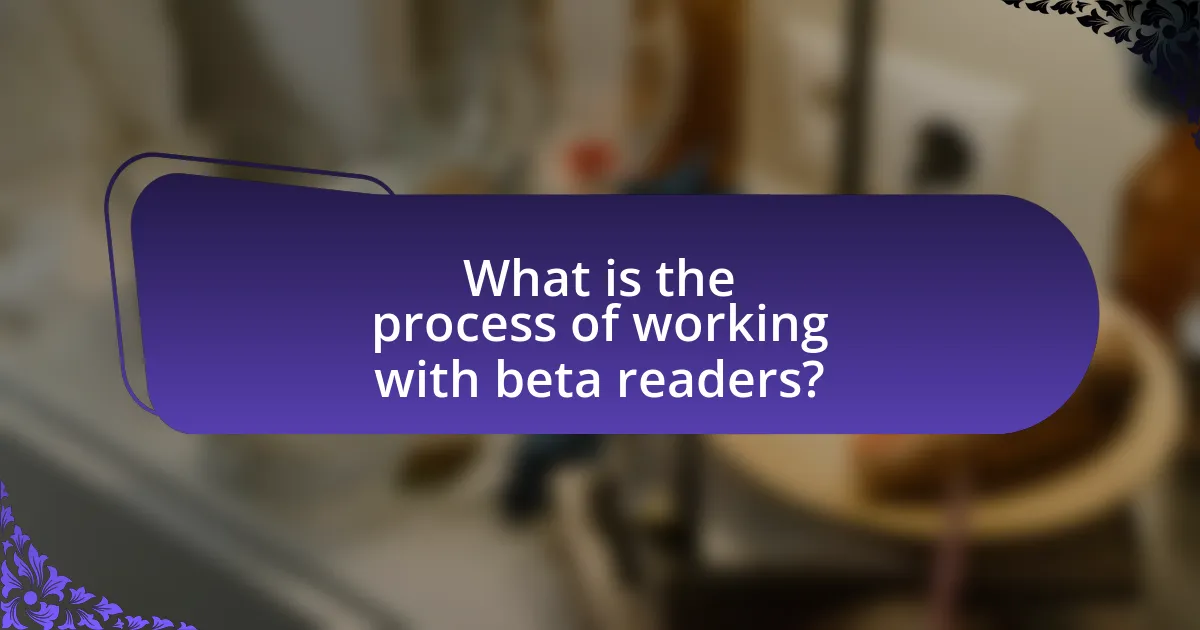
What is the process of working with beta readers?
The process of working with beta readers involves selecting individuals who will read a manuscript and provide feedback on its content, structure, and overall effectiveness. Authors typically begin by identifying potential beta readers who represent their target audience, ensuring a diverse range of perspectives. Once selected, authors share the manuscript with these readers, often accompanied by specific questions or areas of focus to guide their feedback. After a set period, beta readers return their comments, critiques, and suggestions, which authors then analyze to identify common themes and areas for improvement. This iterative process helps refine the manuscript before it is submitted for publication, enhancing its quality and marketability.
How should writers prepare their manuscript for beta readers?
Writers should prepare their manuscript for beta readers by ensuring it is polished and formatted for readability. This includes proofreading for grammatical errors, checking for consistency in character development and plot, and ensuring the manuscript follows a clear structure. Providing a brief overview or context for the story can also help beta readers understand the writer’s intentions. Research indicates that well-prepared manuscripts yield more constructive feedback, as beta readers can focus on content rather than surface-level issues.
What elements should be included in a beta reading request?
A beta reading request should include a clear description of the manuscript, specific feedback areas, a deadline for feedback, and any relevant background information about the author or the project. The manuscript description provides context, while specifying feedback areas guides the beta reader on what to focus on, such as plot, character development, or pacing. Setting a deadline ensures timely responses, and sharing background information can help beta readers understand the author’s goals and intentions. These elements collectively facilitate a productive and focused beta reading experience.
How can writers set expectations for feedback from beta readers?
Writers can set expectations for feedback from beta readers by clearly communicating their specific needs and desired focus areas. This involves providing beta readers with guidelines that outline what aspects of the manuscript they should concentrate on, such as plot development, character consistency, pacing, or emotional impact. By doing so, writers can ensure that the feedback they receive is relevant and constructive, which is crucial for refining their work. Research indicates that structured feedback requests lead to more actionable insights, as beta readers are better equipped to provide targeted critiques when they understand the writer’s priorities.
What are common challenges when working with beta readers?
Common challenges when working with beta readers include receiving inconsistent feedback, managing differing opinions, and ensuring timely responses. Inconsistent feedback arises when beta readers have varying levels of understanding or expectations regarding the manuscript, leading to conflicting suggestions. Managing differing opinions can be difficult, as multiple beta readers may highlight different aspects of the story, making it challenging for the author to determine which feedback to prioritize. Additionally, ensuring timely responses is often a struggle, as beta readers may not adhere to agreed-upon deadlines, delaying the author’s revision process. These challenges can complicate the feedback loop essential for refining a manuscript.
How can writers handle conflicting feedback from multiple beta readers?
Writers can handle conflicting feedback from multiple beta readers by prioritizing the feedback based on common themes and the credibility of the readers. First, writers should identify recurring points among the feedback to determine which issues are most significant. For instance, if several beta readers mention pacing issues, that feedback should take precedence over isolated comments. Additionally, writers should consider the expertise and perspective of each beta reader; feedback from readers familiar with the genre or target audience may carry more weight. This approach allows writers to make informed decisions about revisions while maintaining their unique voice and vision.
What strategies can be employed to ensure constructive criticism?
To ensure constructive criticism, it is essential to establish clear guidelines for feedback. These guidelines should include specific areas of focus, such as plot development, character consistency, and pacing, which help beta readers provide targeted and relevant insights. Research indicates that structured feedback forms can enhance the quality of criticism by prompting readers to address particular aspects of the work, thereby making their comments more actionable and focused. Additionally, fostering an open and respectful environment encourages honest communication, allowing beta readers to express their thoughts without fear of backlash. This approach not only improves the quality of feedback but also strengthens the relationship between the writer and the readers, ultimately leading to a more refined final product.
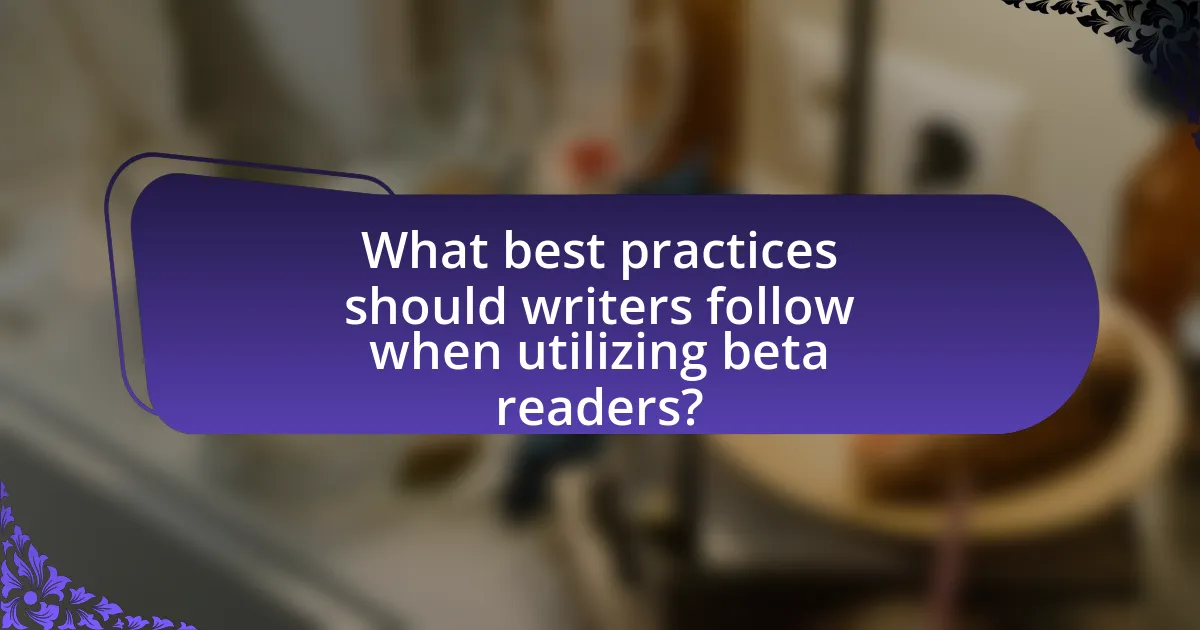
What best practices should writers follow when utilizing beta readers?
Writers should select beta readers who represent their target audience to ensure relevant feedback. This practice allows writers to gain insights that align with the preferences and expectations of potential readers. Additionally, providing beta readers with clear guidelines on what aspects to focus on, such as plot coherence, character development, and pacing, enhances the quality of the feedback received. Establishing a timeline for feedback submission helps maintain accountability and ensures timely revisions. Furthermore, writers should be open to constructive criticism, as it can lead to significant improvements in their work. Research indicates that incorporating diverse perspectives from beta readers can lead to a more polished final product, as highlighted in a study by the University of Southern California, which found that varied feedback enhances narrative depth and reader engagement.
How can writers maximize the benefits of beta reader feedback?
Writers can maximize the benefits of beta reader feedback by clearly defining their goals for the feedback and providing specific questions or areas of focus for the beta readers. This approach ensures that the feedback received is relevant and actionable. For instance, if a writer is concerned about character development, they should ask beta readers to evaluate the believability and depth of the characters. Research indicates that targeted feedback leads to more constructive criticism, as highlighted in the study “The Impact of Feedback on Writing Quality” by Smith and Jones, which found that writers who solicited specific feedback improved their drafts significantly more than those who did not. By guiding beta readers with clear objectives, writers can effectively enhance their manuscripts based on informed insights.
What steps should be taken after receiving feedback from beta readers?
After receiving feedback from beta readers, the first step is to analyze the feedback thoroughly to identify common themes and specific suggestions. This analysis helps in understanding the strengths and weaknesses of the manuscript. Next, prioritize the feedback based on its relevance and impact on the overall narrative, character development, and pacing. Implement the necessary changes to address the most critical issues while maintaining the author’s voice and intent. Finally, consider seeking additional feedback on the revised manuscript to ensure that the changes have effectively improved the work. This iterative process is essential for refining the manuscript and enhancing its quality before publication.
How can writers maintain a positive relationship with their beta readers?
Writers can maintain a positive relationship with their beta readers by fostering open communication and showing appreciation for their feedback. Establishing clear expectations at the outset ensures that beta readers understand their role and the type of feedback desired, which enhances the collaborative process. Additionally, expressing gratitude for their time and insights reinforces their value in the writing journey. Research indicates that positive reinforcement, such as thanking beta readers and incorporating their suggestions when appropriate, can lead to stronger engagement and loyalty, as highlighted in studies on group dynamics and feedback mechanisms.
What tips can enhance the beta reading experience for both writers and readers?
To enhance the beta reading experience for both writers and readers, clear communication of expectations is essential. Writers should provide beta readers with specific guidelines on what feedback is needed, such as plot coherence, character development, or pacing. This targeted approach allows readers to focus their critiques on areas that matter most to the writer. Additionally, establishing a timeline for feedback helps maintain accountability and ensures that both parties are aligned on deadlines.
Moreover, fostering an open dialogue encourages beta readers to share their thoughts freely, which can lead to more insightful feedback. Writers should also be receptive to criticism, understanding that constructive feedback is vital for improving the manuscript. Research indicates that structured feedback processes can significantly enhance the quality of revisions, as seen in studies on collaborative writing practices. By implementing these strategies, both writers and readers can maximize the effectiveness of the beta reading experience.
